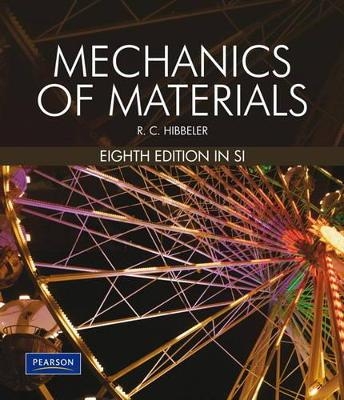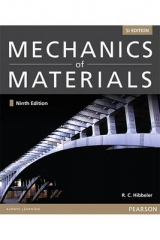
Mechanics of Materials SI with MasteringEngineering Pack
Pearson Education Centre
9789810690137 (ISBN)
- Titel erscheint in neuer Auflage
- Artikel merken
MasteringEngineering SI with eText is the only online tutorial and assessment system that coaches students with answer specific feedback and hints that steer them towards the correct answers. eText is an online version of the textbook that has highlighting, note-taking and search functionality.
About the Author Russell .C. Hibbeler graduated from the University of Illinois at Urbana with a BS in Civil Engineering (major in Structures) and an MS in Nuclear Engineering. He obtained his PhD in Theoretical and Applied Mechanics from Northwestern University. Hibbelers professional experience includes postdoctoral work in reactor safety and analysis at Argonne National Laboratory, and structural work at Chicago Bridge and Iron, as well as Sargent and Lundy in Tucson. He has practiced engineering in Ohio, New York, and Louisiana. Hibbeler currently teaches at the University of Louisiana, Lafayette. In the past he has taught at the University of Illinois at Urbana, Youngstown State University, Illinois Institute of Technology, and Union College. About the Adaptor Fan Sau Cheong who teaches at the Nanyang Technological University (NTU) in Singapore, received his PhD from the University of Hong Kong. Professor Fan is also Deputy Director, Centre for Advanced Numerical Engineering Simulations (CANES) at NTU. His industrial experience includes work and research on bridges, tall buildings, shell structures, jetties, pavements, cable structures, glass diaphragm walls and more. Professor Fan was also the adaptor for the 5th, 6th and 7th SI editions of Hibbelers Mechanics of Materials, and the 11th & 12th SI edition of Hibbelers Engineering Mechanics: Statics and Dynamics.
Chapter 1: Stress
1.1 Introduction
1.2 Equilibrium of a Deformable Body
1.3 Stress
1.4 Average Normal Stress in an Axially Loaded Bar
1.5 Average Shear Stress
1.6 Allowable Stress
1.7 Design of Simple Connections
Chapter 2: Strain
2.1 Deformation
2.2 Strain
Chapter 3: Mechanical Properties of Materials
3.1 The Tension and Compression Test
3.2 The StressStrain Diagram
3.3 StressStrain Behavior of Ductile and Brittle Materials
3.4 Hookes Law
3.5 Strain Energy
3.6 Poissons Ratio
3.7 The Shear StressStrain Diagram
3.8 Failure of Materials Due to Creep and Fatigue
Chapter 4: Axial Load
4.1 Saint-Venants Principle
4.2 Elastic Deformation of an Axially Loaded Member
4.3 Principle of Superposition
4.4 Statically Indeterminate Axially Loaded Member
4.5 The Force Method of Analysis for Axially Loaded Members
4.6 Thermal Stress
4.7 Stress Concentrations
4.8 Inelastic Axial Deformation
4.9 Residual Stress
Chapter 5: Torsion
5.1 Torsional Deformation of a Circular Shaft
5.2 The Torsion Formula
5.3 Power Transmission
5.4 Angle of Twist
5.5 Statically Indeterminate Torque-Loaded Members
5.6 Solid Noncircular Shafts
5.7 Thin-Walled Tubes Having Closed Cross Sections
5.8 Stress Concentration
5.9 Inelastic Torsion
5.10 Residual Stress
Chapter 6: Bending
6.1 Shear and Moment Diagrams
6.2 Graphical Method for Constructing Shear and Moment Diagrams
6.3 Bending Deformation of a Straight Member
6.4 The Flexure Formula
6.5 Unsymmetric Bending
6.6 Composite Beams
6.7 Reinforced Concrete Beams
6.8 Curved Beams
6.9 Stress Concentrations
6.10 Inelastic Bending
Chapter 7: Transverse Shear
7.1 Shear in Straight Members
7.2 The Shear Formula
7.3 Shear Flow in Built-Up Members
7.4 Shear Flow in Thin-Walled Members
7.5 Shear Center for Open Thin-Walled Members
Chapter 8: Combined Loadings
8.1 Thin-Walled Pressure Vessels
8.2 State of Stress Caused by Combined Loadings
Chapter 9: Stress Transformation
9.1 Plane-Stress Transformation
9.2 General Equations of Plane-Stress Transformation
9.3 Principal Stresses and Maximum In-Plane Shear Stress
9.4 Mohrs CirclePlane Stress
9.5 Absolute Maximum Shear Stress
Chapter 10: Strain Transformation
10.1 Plane Strain
10.2 General Equations of Plane-Strain Transformation
10.3 Mohrs CirclePlane Strain
10.4 Absolute Maximum Shear Strain
10.5 Strain Rosettes
10.6 Material-Property Relationships
10.7 Theories of Failure
Chapter 11: Design of Beams and Shafts
11.1 Basis for Beam Design
11.2 Prismatic Beam Design
11.3 Fully Stressed Beams
11.4 Shaft Design
Chapter 12: Deflection of Beams and Shafts
12.1 The Elastic Curve
12.2 Slope and Displacement 12 by Integration
12.3 Discontinuity Functions
12.4 Slope and Displacement by the Moment-Area Method
12.5 Method of Superposition
12.6 Statically Indeterminate Beams and Shafts
12.7 Statically Indeterminate Beams and ShaftsMethod of Integration
12.8 Statically Indeterminate Beams and ShaftsMoment-Area Method
12.9 Statically Indeterminate Beams and ShaftsMethod of Superposition
Chapter 13: Buckling of Columns
13.1 Critical Load
13.2 Ideal Column with Pin Supports
13.3 Columns Having Various Types of Supports
13.4 The Secant Formula
13.5 Inelastic Buckling
13.6 Design of Columns for Concentric Loading
13.7 Design of Columns for Eccentric Loading
Chapter 14: Energy Methods
14.1 External Work and Strain Energy
14.2 Elastic Strain Energy for Various Types of Loading
14.3 Conservation of Energy
14.4 Impact Loading
14.5 Principle of Virtual Work
14.6 Method of Virtual Forces Applied to Trusses
14.7 Method of Virtual Forces Applied to Beams
14.8 Castiglianos Theorem
14.9 Castiglianos Theorem Applied to Trusses
14.10 Castiglianos Theorem Applied to Beams
Appendix A: Geometric Properties of An Area
A.1 Centroid of an Area
A.2 Moment of Inertia for an Area
A.3 Product of Inertia for an Area
A.4 Moments of Inertia for an Area about Inclined Axes
A.5 Mohrs Circle for Moments of Inertia
Appendix B: Geometric Properties of Structural Shapes
Appendix C: Slopes and Deflections of Beams
| Erscheint lt. Verlag | 12.1.2012 |
|---|---|
| Verlagsort | Singapore |
| Sprache | englisch |
| Maße | 203 x 236 mm |
| Gewicht | 1460 g |
| Themenwelt | Technik ► Maschinenbau |
| ISBN-13 | 9789810690137 / 9789810690137 |
| Zustand | Neuware |
| Informationen gemäß Produktsicherheitsverordnung (GPSR) | |
| Haben Sie eine Frage zum Produkt? |
aus dem Bereich



